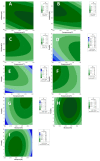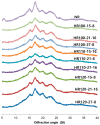Enhancing Resistant Starch Content of High Amylose Rice Starch through Heat-Moisture Treatment for Industrial Application
- PMID: 36234911
- PMCID: PMC9573617
- DOI: 10.3390/molecules27196375
Enhancing Resistant Starch Content of High Amylose Rice Starch through Heat-Moisture Treatment for Industrial Application
Abstract
The objective of the present study is to enhance the resistant starch (RS) content of high amylose rice starch with heat-moisture treatment (HMT) for industrial application. The optimized HMT condition for achieving the highest RS content established using response surface methodology (RSM) was a temperature of 100 °C, moisture content of 24.2%, and a time of 11.5 h. Upon HMT, the RS content increased from 32.1% for native starch to 46.4% in HMT starch with optimized condition. HMT of the starches reduced the solubility and swelling power. The surface of HMT starch granules was more irregular than native starch. The X-ray diffraction (XRD) peak intensity at 2θ = 5° was greatly reduced by HMT, and the peaks at 22.7° and 24.2° were merged. HMT increased the gelatinization temperature and reduced the gelatinization enthalpy. HMT provides a method for the production of high-yield RS2 with high amylose rice starch in industrial application.
Keywords: granular morphology; heat–moisture treatment; high amylose rice starch; physicochemical properties; resistant starch; response surface methodology.
Conflict of interest statement
The authors declare no conflict of interest.
Figures




Similar articles
-
Physicochemical differences between sorghum starch and sorghum flour modified by heat-moisture treatment.Food Chem. 2014 Feb 15;145:756-64. doi: 10.1016/j.foodchem.2013.08.129. Epub 2013 Sep 7. Food Chem. 2014. PMID: 24128541
-
Influence of moisture and amylose on the physicochemical properties of rice starch during heat treatment.Int J Biol Macromol. 2021 Jan 31;168:656-662. doi: 10.1016/j.ijbiomac.2020.11.122. Epub 2020 Nov 18. Int J Biol Macromol. 2021. PMID: 33220369
-
Effect of single and dual heat-moisture treatments on properties of rice, cassava, and pinhao starches.Carbohydr Polym. 2013 Nov 6;98(2):1578-84. doi: 10.1016/j.carbpol.2013.07.036. Epub 2013 Jul 20. Carbohydr Polym. 2013. PMID: 24053843
-
The impact of heat-moisture treatment on molecular structures and properties of starches isolated from different botanical sources.Crit Rev Food Sci Nutr. 2010 Oct;50(9):835-47. doi: 10.1080/10408390903001735. Crit Rev Food Sci Nutr. 2010. PMID: 20924866 Review.
-
A review on research advances in efficient approaches to augment hydrothermal techniques for starch functionalization: Mechanisms, properties and potential food applications.Carbohydr Polym. 2025 Jun 1;357:123441. doi: 10.1016/j.carbpol.2025.123441. Epub 2025 Feb 26. Carbohydr Polym. 2025. PMID: 40158978 Review.
Cited by
-
Physicochemical properties of starch of four varieties of native potatoes.Heliyon. 2024 Aug 5;10(16):e35809. doi: 10.1016/j.heliyon.2024.e35809. eCollection 2024 Aug 30. Heliyon. 2024. PMID: 39220980 Free PMC article.
-
Harnessing the power of resistant starch: a narrative review of its health impact and processing challenges.Front Nutr. 2024 Mar 20;11:1369950. doi: 10.3389/fnut.2024.1369950. eCollection 2024. Front Nutr. 2024. PMID: 38571748 Free PMC article. Review.
-
Nutrition and Gut Health: Preparation and Efficacy of Resistant Starch.Foods. 2025 Feb 1;14(3):471. doi: 10.3390/foods14030471. Foods. 2025. PMID: 39942065 Free PMC article. Review.
-
Effects of RBX oleogel and heat-moisture-treated rice flour in food matrices on digestibility and microbiota.NPJ Sci Food. 2025 Apr 22;9(1):54. doi: 10.1038/s41538-025-00418-7. NPJ Sci Food. 2025. PMID: 40263295 Free PMC article.
-
Potential of Process-Induced Modification of Potato Starch to Modulate Starch Digestibility and Levels of Resistant Starch Type III.Foods. 2025 Mar 4;14(5):880. doi: 10.3390/foods14050880. Foods. 2025. PMID: 40077583 Free PMC article.
References
-
- Aschemann-Witzel J., Varela P., Peschel A.O. Consumers’ categorization of food ingredients: Do consumers perceive them as ‘clean label’ producers expect? An exploration with projective mapping. Food Qual. Prefer. 2019;71:117–128. doi: 10.1016/j.foodqual.2018.06.003. - DOI
-
- Huang M., No J., Shin M. Effects of heat-moisture treatment on functional properties of high amylose rice starches with different crystalline types. Korean J. Food Sci. Technol. 2020;52:31–39.
-
- Cindy S., Pieter L.B. Starch in Food: Structures, Function and Applications. 2nd ed. Woodhead Publishing; Cambridge, MA, USA: 2017. pp. 357–375.
MeSH terms
Substances
LinkOut - more resources
Full Text Sources

